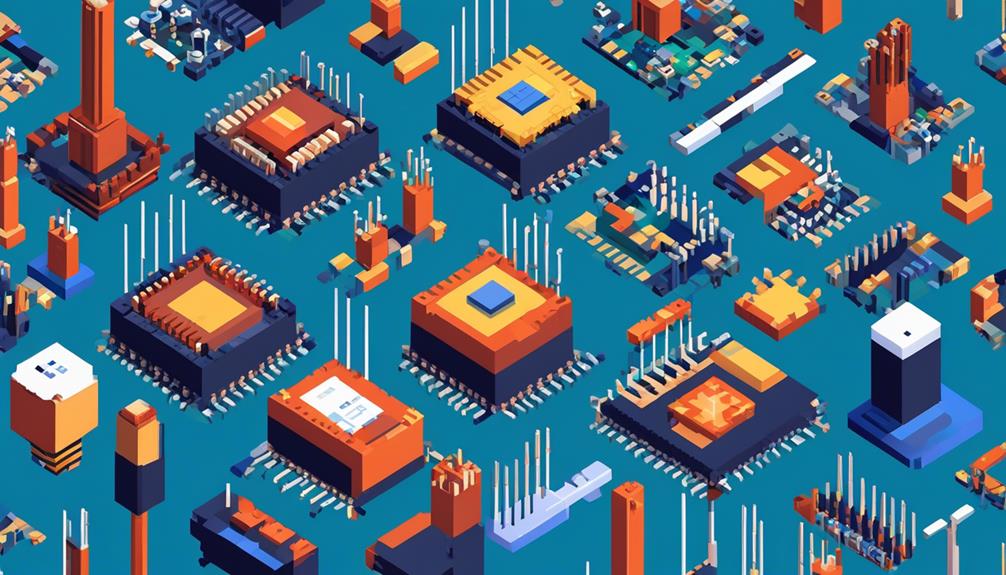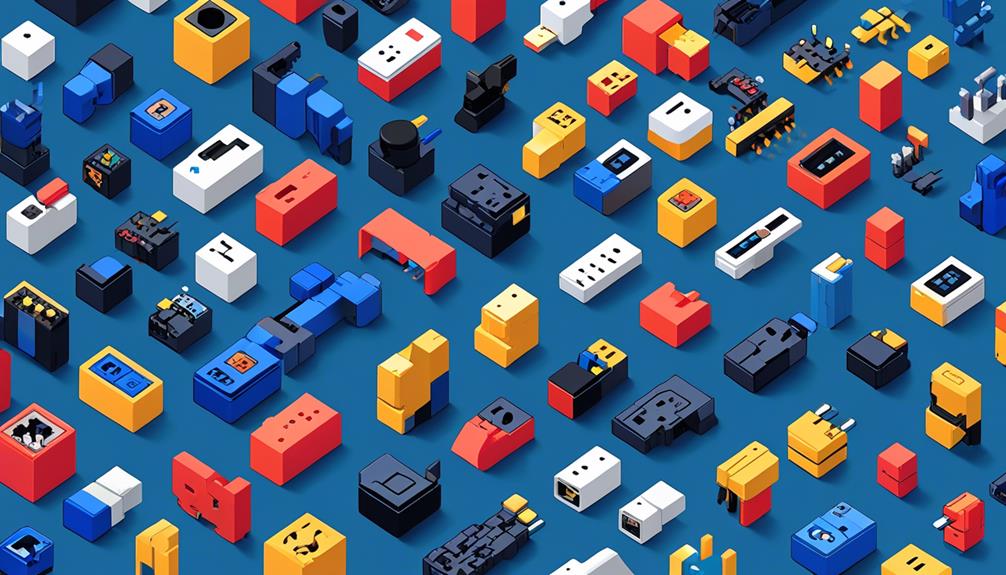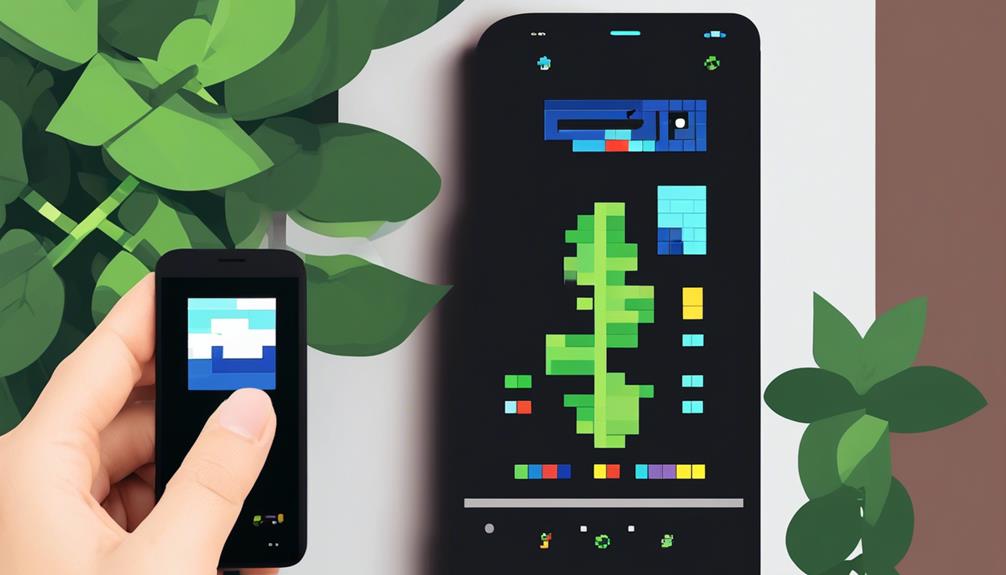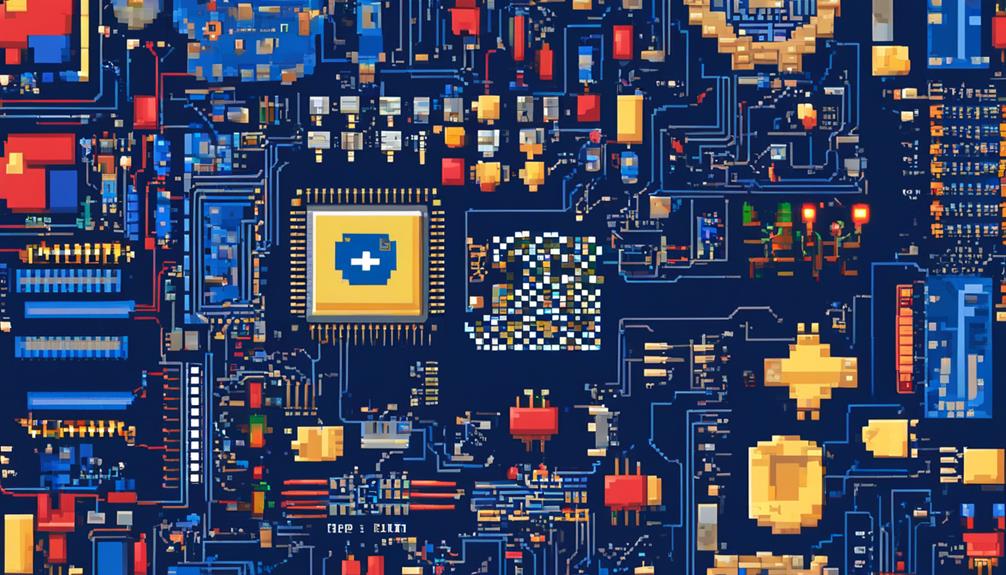Bluetooth Hardware Essentials play a crucial role in the development and implementation of Bluetooth Low Energy technology. From client emulator apps to power measurement tools, these resources provide developers with the necessary tools and knowledge for successful Bluetooth development.
However, there is more to explore beyond these essentials. In this discussion, we will delve into the various components that make up the Bluetooth hardware ecosystem, such as Bluetooth modules, development boards, antennas, beacons, adapters, audio devices, sensors, transceivers, and evaluation kits.
By understanding the intricacies of these hardware essentials, developers can unlock the full potential of Bluetooth technology and create innovative solutions that meet the ever-evolving demands of the market.
Key Takeaways
- Bluetooth Modules and Development Boards are cost-effective solutions for rapid prototyping and testing, providing compact integrated circuits and facilitating hands-on experimentation.
- Proper selection and placement of Antennas and RF Connectors are crucial for optimal wireless performance, impacting range, data throughput, and power consumption.
- Bluetooth Beacons, utilizing Bluetooth Low Energy (BLE) technology, are small wireless devices used for location-based services, proximity marketing, and potential asset tracking in various industries.
- Bluetooth Adapters enable connectivity between non-Bluetooth devices and Bluetooth technology, expanding the range of devices compatible with Bluetooth and enhancing connectivity options for different applications.
Bluetooth Modules

Bluetooth modules are compact, integrated circuits specifically designed for wireless communication utilizing Bluetooth technology. These modules serve as essential hardware components in Bluetooth devices, enabling seamless connectivity and data transfer between devices. They consist of a Bluetooth radio, microcontroller, and software stack, which work together to simplify the process of adding Bluetooth functionality to a device.
Bluetooth modules come in various form factors to cater to different application requirements. They can be found in surface-mount designs or modules with external antennas, allowing for flexibility in device design and placement. Additionally, some modules offer additional features such as low energy consumption, Bluetooth mesh networking support, and compatibility with different Bluetooth profiles. This versatility makes Bluetooth modules suitable for a wide range of applications, including IoT devices, wearables, smart home devices, and industrial automation.
The use of Bluetooth modules in these applications provides several benefits. They enable wireless communication, eliminating the need for physical connectors and cables. This allows for greater mobility and flexibility in device usage. Bluetooth modules also provide a reliable and secure means of communication, ensuring data integrity and privacy. Moreover, the integration of Bluetooth modules simplifies the development process, as manufacturers can leverage pre-built modules with pre-tested software stacks, reducing time-to-market and development costs.
Development Boards
Development boards play a crucial role in facilitating hands-on experimentation and practical implementation of Bluetooth technology. These boards serve as the foundation for developing various Bluetooth applications, supporting serial communication, and enabling developers to gain practical experience in implementing Bluetooth technology in their projects.
Examples of development boards include the ESP32 Thing Plus and the Pro nRF52840 Mini.
These development boards are designed to be compatible with the Bluetooth Specification and provide an ideal platform for developers to explore the capabilities of Bluetooth technology. They support Bluetooth Low Energy (LE), which is commonly used in modern Bluetooth applications due to its energy efficiency. This makes them suitable for a wide range of projects, including IoT devices, wireless sensors, and wearable devices.
The ESP32 Thing Plus development board, priced at $22.50, offers a powerful dual-core processor, integrated Wi-Fi, and Bluetooth capabilities. It provides a convenient platform for rapid prototyping and development of Bluetooth-enabled projects.
The Pro nRF52840 Mini, priced at $32.50, is another popular development board that offers advanced features such as a Cortex-M4 processor, USB connectivity, NFC support, and a wide range of GPIO pins.
These development boards have received positive feedback from developers for their features, capabilities, and ease of use. They provide a cost-effective solution for getting started with Bluetooth development and allow developers to quickly prototype and test their ideas.
Antennas and RF Connectors

Antennas and RF connectors play a crucial role in ensuring optimal wireless performance and connectivity in Bluetooth devices. Here are some important facts about antennas and RF connectors in the context of Bluetooth hardware:
- Antennas: The antenna is responsible for transmitting and receiving radio frequency signals in Bluetooth devices. It converts electrical signals into electromagnetic waves and vice versa. The design and placement of the antenna are critical factors in achieving reliable and efficient wireless communication. Antennas come in various types, such as chip antennas, PCB antennas, and external antennas, each with its own advantages and limitations.
- RF Connectors: RF connectors are used to connect the antenna to the Bluetooth module or chipset in the device. These connectors provide a secure and reliable electrical connection between the antenna and the rest of the Bluetooth hardware. Common types of RF connectors used in Bluetooth devices include SMA, U.FL, and MMCX connectors. The choice of connector depends on factors such as space constraints, ease of assembly, and electrical performance requirements.
Proper selection and placement of antennas are crucial for achieving optimal wireless performance in Bluetooth devices. The characteristics and specifications of antennas and RF connectors directly impact the range, data throughput, and power consumption of the Bluetooth system. Designers need to consider factors such as frequency band, gain, radiation pattern, and impedance matching when selecting antennas. RF connectors should be chosen based on factors like impedance, insertion loss, and durability.
In Bluetooth devices, low power consumption and energy efficiency are important considerations. By selecting the appropriate antennas and optimizing the RF connection, designers can ensure that the Bluetooth device operates efficiently while maintaining reliable wireless connectivity. Careful attention to antenna design and RF connector selection can significantly improve the overall performance and user experience of Bluetooth devices.
Bluetooth Beacons
Bluetooth beacons are small wireless devices that transmit a continuous signal to communicate with nearby Bluetooth-enabled devices. These hardware essentials play a crucial role in enabling location-based services and proximity marketing. Developed by the Bluetooth Special Interest Group (Bluetooth SIG), beacons utilize Bluetooth Low Energy (BLE) technology, allowing them to operate for extended periods without frequent battery replacements.
Bluetooth beacons are commonly used in various industries, particularly in retail environments. They facilitate proximity marketing by providing information about nearby points of interest and triggering location-specific actions in mobile apps. Additionally, they are employed in indoor navigation systems to enhance user experience and improve wayfinding capabilities.
The configuration and management of Bluetooth beacons can be accomplished through dedicated beacon management platforms or beacon-specific mobile apps. These tools allow users to customize beacon settings, monitor battery life, and update firmware remotely. This streamlined approach simplifies the deployment and maintenance of large-scale beacon networks.
Bluetooth beacons offer immense potential for asset tracking in industries such as logistics and healthcare. By attaching beacons to assets or equipment, businesses can monitor their location and movement in real-time. This aids in optimizing workflows, improving inventory management, and minimizing losses.
Bluetooth Adapters

With the discussion on Bluetooth beacons concluded, we now turn our attention to a vital component in enabling connectivity between non-Bluetooth devices and Bluetooth technology – Bluetooth adapters. These adapters come in various forms, such as USB dongles, cards, and external modules, and play a crucial role in expanding the capabilities of non-Bluetooth devices.
Bluetooth adapters allow for seamless wireless communication between non-Bluetooth devices and Bluetooth-enabled peripherals. They enable data transfer between devices like PCs, laptops, and audio systems with Bluetooth-enabled devices such as speakers, headphones, and smartphones. By adding Bluetooth functionality to non-Bluetooth devices, these adapters eliminate the need for wired connections and provide a convenient and efficient way to connect peripheral devices.
When selecting a Bluetooth adapter, it is important to consider the Bluetooth version compatibility. Bluetooth adapters are available in different versions, including Bluetooth 4.0, 5.0, and Bluetooth Low Energy (BLE). Choosing the right version ensures compatibility with a wide range of Bluetooth-enabled devices and ensures optimal data transfer rates.
Bluetooth Audio Devices
Bluetooth audio devices encompass a range of wireless peripherals, including headsets, earbuds, speakers, and headphones, that utilize Bluetooth technology for seamless and convenient audio transmission. These devices connect to smartphones, tablets, computers, and other Bluetooth-enabled devices to provide wireless audio playback. Bluetooth audio devices offer convenience, portability, and freedom of movement without the constraints of wired connections. They often feature built-in microphones for hands-free calling and voice assistant functionality. Many Bluetooth audio devices support advanced features like noise cancellation, voice command activation, and multi-device pairing for a seamless user experience.
To further understand the capabilities and specifications of Bluetooth audio devices, the following table provides an overview of the Bluetooth audio profiles commonly used:
| Bluetooth Profile | Description |
|---|---|
| Headset Profile (HSP) | Enables basic headset functionality, such as call control and audio streaming. |
| Hands-Free Profile (HFP) | Allows for enhanced call control features, including echo cancellation and noise reduction. |
| Advanced Audio Distribution Profile (A2DP) | Enables high-quality stereo audio streaming. |
| Audio/Video Remote Control Profile (AVRCP) | Provides remote control functionality for audio and video playback. |
| Personal Area Network Profile (PAN) | Supports the creation of a personal area network for sharing data between devices. |
Bluetooth audio devices adhere to the Bluetooth Standard, which ensures compatibility and interoperability across different devices. This standard defines the protocols, profiles, and specifications necessary for Bluetooth devices to communicate effectively.
Bluetooth Sensors

Bluetooth sensors are advanced devices capable of detecting and measuring various environmental conditions and parameters without the constraints of wired connections. These sensors play a crucial role in IoT applications, smart home devices, and industrial monitoring systems. They offer the advantage of low power consumption and seamless integration with Bluetooth-enabled devices.
Bluetooth sensors can monitor a wide range of physical properties, including temperature, humidity, air quality, motion, light, and more. They utilize Bluetooth technology to transmit data wirelessly to a compatible device or gateway for further processing and analysis. This wireless communication is made possible by the Bluetooth Low Energy (LE) technology, which ensures efficient data transmission while minimizing power consumption.
To ensure interoperability and standardized communication, Bluetooth sensors adhere to specific profiles defined by the Bluetooth Special Interest Group (SIG). These profiles define the data format and communication protocols for different sensor types. Some commonly used profiles include the Generic Attribute Profile (GATT) for data exchange and the Environmental Sensing Profile (ESP) for environmental monitoring.
Bluetooth sensors are designed to be compact and energy-efficient, allowing for long battery life and extended monitoring periods. They can be easily integrated into a variety of devices, making them ideal for applications such as smart thermostats, fitness trackers, indoor air quality monitors, and more.
Bluetooth Transceivers
Building upon the capabilities of Bluetooth sensors, Bluetooth transceivers serve as essential components in enabling bidirectional communication between devices using Bluetooth technology. These transceivers consist of both a transmitter and a receiver, allowing devices to send and receive data over Bluetooth connections. Bluetooth transceivers support various protocols and standards, including Bluetooth Classic and Bluetooth Low Energy (BLE), providing flexibility and compatibility with different devices.
One key aspect of Bluetooth transceivers is their low power consumption. This is especially important in applications where energy efficiency is crucial, such as wearable devices and Internet of Things (IoT) devices. Bluetooth Low Energy (BLE) transceivers, in particular, are designed to minimize power consumption, allowing devices to operate for extended periods without requiring frequent battery replacements.
To highlight the importance of power efficiency in Bluetooth transceivers, consider the following table:
| Bluetooth Transceiver | Power Consumption |
|---|---|
| Bluetooth Classic | Moderate |
| Bluetooth Low Energy | Low |
As seen in the table, Bluetooth Low Energy transceivers have significantly lower power consumption compared to Bluetooth Classic transceivers. This makes them ideal for devices that require long battery life or operate on limited power sources.
Bluetooth transceivers play a crucial role in enabling various functionalities in Bluetooth-enabled devices. They facilitate wireless audio streaming, data transfer, and device control over Bluetooth connections. Whether it's connecting a smartphone to wireless headphones or wirelessly transferring data between devices, Bluetooth transceivers are essential for seamless and efficient communication.
Bluetooth Evaluation Kits

Bluetooth Evaluation Kits provide developers with a comprehensive platform for assessing and experimenting with the capabilities and limitations of Bluetooth technology. These kits play a crucial role in understanding and implementing cutting-edge Bluetooth features in a wide range of applications.
Key features and benefits of Bluetooth Evaluation Kits include:
- Hardware, Software, and Documentation: These kits typically include all the necessary components, including the hardware, software, and detailed documentation. This comprehensive package aids developers in the evaluation and development process.
- Sample Applications and Demonstration Codes: Bluetooth Evaluation Kits often come with pre-loaded sample applications and demonstration codes. These resources help users understand and implement various Bluetooth features, such as pairing, data transfer, and Bluetooth profiles.
Bluetooth Evaluation Kits serve as valuable tools for testing, prototyping, and evaluating Bluetooth-enabled devices and applications. By providing a complete platform, these kits enable developers to assess the performance and functionality of Bluetooth technology in real-world scenarios.
Developers can leverage Bluetooth Evaluation Kits to explore the capabilities and limitations of Bluetooth technology and its integration into their specific projects. Whether it's designing a wearable device, creating a smart home application, or developing an industrial IoT solution, these kits offer a hands-on approach to understanding and utilizing Bluetooth technology effectively.
Frequently Asked Questions
What Hardware Is Required for Bluetooth?
Bluetooth hardware is essential for establishing wireless connections between devices. It includes Bluetooth adapters, dongles, and internal chipsets that enable Bluetooth functionality. These hardware components ensure Bluetooth device compatibility and allow for data transmission within a limited range.
However, Bluetooth range limitations and potential security concerns should be addressed. Troubleshooting interference issues and staying up-to-date with hardware advancements are crucial for a reliable and secure Bluetooth experience.
What Components Are Needed for Bluetooth?
To set up a Bluetooth connection, several components are needed.
Bluetooth module types determine the functionality and features of the connection.
Bluetooth antenna design ensures optimal signal transmission and reception.
Bluetooth power requirements dictate the energy consumption of the devices.
The Bluetooth pairing process establishes a secure connection between devices.
Lastly, Bluetooth security measures, such as encryption and authentication, protect the data transmitted over the connection.
These components work together to enable seamless and secure Bluetooth communication.
What Is Required for Bluetooth to Work?
Bluetooth requires compatibility in smartphones, smartwatches, car audio systems, home automation devices, and gaming consoles. These devices must have Bluetooth hardware and software to establish a connection. Bluetooth technology enables wireless communication within a range of up to 10 meters. Devices need to have Bluetooth enabled and be discoverable.
A secure pairing process is necessary for connecting two Bluetooth devices. Additionally, both devices must support the same Bluetooth profile to ensure specific functionalities.
What Is Needed for Bluetooth on Pc?
Is your PC equipped with Bluetooth technology? Do you have the necessary drivers installed? If not, you may need to purchase an external Bluetooth adapter to enable Bluetooth functionality on your PC.
Once you have the hardware and drivers in place, you can easily pair your PC with Bluetooth-enabled devices such as keyboards, mice, and headsets.
In case of any connectivity issues, troubleshooting common problems and their solutions can help ensure a seamless Bluetooth experience on your PC.
